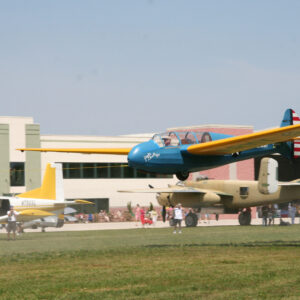TG-4A was a conventional sailplane design with a fuselage of steel tube construction and spruce and mahogany plywood cantilever wings and tail, skinned all over with fabric. The pilot and instructor sat in tandem under a long canopy. Interestingly, the gliders were equipped with SCR-585 radios to allow the glider to communicate with the tow plane.
The Museum’s TG-4A (42-53072) was ordered in 1942 and manufactured in St Louis, Missouri. It was one of 150 that were built to be used for training during WWII. Production of the type ceased in June 1943. It was restored by Windsor, VA glider enthusiast and WWII CG-4A veteran Joe Mathias, Jr. who flew it into the Museum to join the collection.
Did You know?
Glider pilot wings are emblazoned with the letter G, which they said, stood for guts.
Specifications
- Number Built: 153
- Year Produced: 1943
- Serial Number: 126
- Crew: (2) Pilot, Student Pilot
- Current Pilots:
Dimensions
- Length: 21 ft. 3 in.
- Wingspan: 50 ft.
- Empty Weight: 475 lbs.
- Loaded Weight: 875 lbs.
- Engine: N/A – unpowered
- Engine Power: N/A
Performance
- Cruising Speed: L/D max 22@55 mph; min sink 3.2 fps@45 mph; 6 fps sink@65 mph
- Max Speed: 126 mph never exceed speed
- Range: dependent on soaring conditions
- Ceiling: 14,000 ft
- Rate of Climb: dependent on soaring conditions
Armament
- N/A – unarmed

